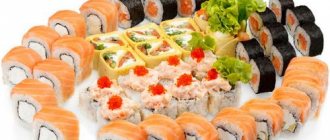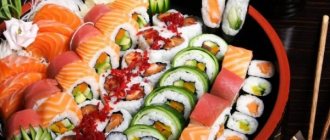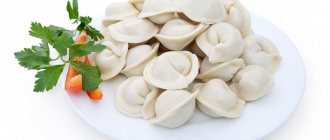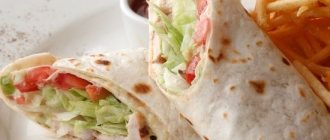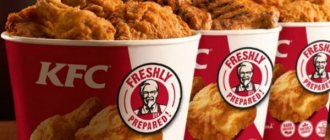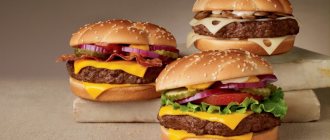How many calories are in rolls?
Rolls prepared according to a Japanese recipe are low in calories. But depending on the ingredients, the energy value of a Japanese dish also increases - for example, fatty fish and cheese are quite fatty foods. Rolls with vegetables and crab fillet have the lowest calorie content. You should also not forget about rice - despite the apparent dryness, the grains are soaked in vinegar and soy sauce, which gives them additional energy value.
If you consider less calorie rolls, you should pay attention to dietary dishes of Chinese or Korean cuisine, for example, “California” or “Alaska”.
In general, rolls can be considered a low-calorie and even healthy food. Nutritionists recommend Japanese cuisine as the best food option for weight loss. Seafood enriches the digestive system with a whole group of vitamins and amino acids.
Interesting fact! Fish and rice create a unique combination of nutrients that prevent the destruction of tissue in the human body. Improved metabolism helps reduce the rate of aging. This is evidenced by examples of eastern centenarians.
The role of sushi and rolls in losing weight
If you choose the right ingredients, rolls can be dietary and benefit the body. Sushi on a diet saturates the body with microelements and helps you lose weight while giving up sweets and unhealthy foods.
It is recommended to strictly monitor the amount of sushi: the daily dose should not exceed 20 pieces. Rolls themselves do not affect fat burning, but together with dietary dishes they can activate metabolism.
Avoid fried rolls
It is worth understanding that when losing weight, sushi fried in batter is a forbidden dish: this method of preparation and oil can double the calorie content of the dish.
Frying sushi requires a lot of oil and special breadcrumbs (tempura), which contain a lot of fat. It is better to be content with vegetable sushi with classic seafood.
Don't get carried away with cream cheese
Another tip for losing weight is to avoid rolls with cream cheese. It contains a lot of saturated carbohydrates, its consumption slows down digestion and promotes weight gain.
Excessively large amounts of cheese have a negative effect on the liver and increase cholesterol levels.
Skip the toppings
Sushi contains many ingredients that add weight to the dish. Toppings in Japanese cuisine can include extra sauce, avocado, pieces of crab and flying fish roe.
These foods increase the calorie content of food, so they should be excluded.
Replace white rice with brown rice
White rice itself is difficult for the body; it contains a lot of fat, which takes a long time to be absorbed in the body and slows down metabolism. It is better to replace white rice with brown rice.
The latter contains a lot of magnesium and zinc, which are important for the normal functioning of the body. In addition, brown rice is a natural source of fiber, which helps burn fat.
Sashimi (raw fish without rice) is the best option
The best option on a sushi diet is sashimi - a variety of raw fish without garnish. Such nutrition saturates the body with iodine and fluoride, but it is not recommended for everyone.
Some people's bodies are unable to accept raw fish, resulting in nausea and gastrointestinal problems. Only certain types of fish can be eaten raw. Salmon, scallops, sea bass, etc. are used to prepare sashimi.
Tuna and salmon should be your favorite friends
Salmon and tuna must be present in the diet. Their meat contains a lot of iron and fluorine, and therefore it is useful for the body when losing weight.
To reduce the calorie content of tuna rolls, it is advised to use lightly salted fish, a little meat, and completely remove sauces and cheese. By giving up smoked fish, you can cut your calorie intake by almost half.
Add vegetables to the roll
Adding vegetables as a filling will significantly reduce the energy value of the dish, reduce the heaviness of the rice and refresh the taste.
Vegetables can act as substitutes for fat-containing foods such as smoked fish, ham, cheese and others.
Don't skip the ginger and wasabi
Despite the deep-rooted opinion about the dangers of sauces in rolls, it is better not to refuse some toppings.
Wasabi and ginger speed up metabolism, activate blood flow and improve digestion.
They will start cleansing the body and improve the breakdown of fiber.
How many calories are in Philadelphia rolls?
Let's look at the energy value using a specific example - let's take the classic "Philadelphia" as a basis.
List of ingredients:
- Pressed seaweed (nori) enriches our body with vitamins A and C, carbohydrates and minerals. Nori helps get rid of varicose veins. Sea plants improve immunity and reduce cholesterol levels.
- Rice - includes vitamins of groups E, PP and B, trace elements and minerals. It is the white grains that are responsible for neutralizing toxins in the body thanks to coarse fibers.
- Salmon – contains groups of vitamins B12, D and E. The fish delicacy enriches our body with omega fats and healthy amino acids.
- Philadelphia (cheese) – rich in vitamin complex A, B, E, K, PP, minerals and macroelements. Cheese promotes better digestibility of food, in particular fatty fish.
The calorie content of Philadelphia rolls of the Japanese serving size is 142 kilocalories per 100 grams.
Nutritional value is presented: proteins – 9.7 g, fats – 6.7 g. and carbohydrates – 10.8 g.
How many calories are in salmon rolls?
If you have time and decide to make homemade rolls, then don’t be surprised that the calorie content of homemade rolls will be higher than that of a traditional Japanese dish. It's all about the recipe and the ingredients used.
When counting calories, you should focus on the following data:
- · Rice – 332 Kcal per 100 g;
- · Salmon – 195 Kcal per 100 g;
- · Vinegar – 11 Kcal per 100 ml;
- · Soy sauce – 68 Kcal per 100 g;
- · Wasabi – 57 Kcal per 100 g.
When adding salt or pickled ginger, you should also consider its calorie content. So, 100 grams of ginger contains approximately 15 kilocalories.
When making calculations, you may encounter a situation where the manufacturer indicates calories not for one serving, but for the whole dish. At the same time, rice with salmon is much lower in calories than a similar portion with tuna. If you stuff rolls with shrimp, avocado or cucumber, the average calorie value will be approximately 100 Kcal per 1 roll (6 pieces)
Approximate nutritional value of a classic salmon product:
Calories – 169 kcal, proteins – 6 grams, fats – 4 grams, carbohydrates – 28 grams.
Calorie content of rolls: Philadelphia, California, with cucumber, with salmon
You are here: Home > Articles > Cooking > Calorie content of foods
March 14, 2020 | views: 17,057
Recently, Japanese cuisine has become increasingly popular in Europe, the USA, and the CIS countries. The rather low calorie content of rolls and sushi, their specific taste and healthiness (using quality products) have made this dish a favorite among connoisseurs of Japanese cuisine. It consists of rice seasoned with rice vinegar and various fillings. In classic sushi, the filling consists of seafood, but local chefs, adapting them to the European market, use any filling, for example, meat, which is simply nonsense for the Japanese.
There are many types of this dish and some of them are described below:
- Nigirizushi is the most common type of sushi in Japan. They are a lump of hand-made rice and a thin slice of chopped fish on top. Sometimes the fish is tied to the rice with a strip of nori.
- Makizushi are those same rolls. They have a cylindrical shape, which is given to them by a special bamboo mat. Rolls with the filling inside are wrapped in nori leaves or omelette. There are two most common types of makizushi: futomaki (roll with nori on the outside) and uramaki (nori on the inside). Uramaki is often sprinkled with caviar or sesame seeds.
Ingredients
The calorie content of rolls depends on the ingredients used in preparation. The main ones include:
- Rice. The rolls are made from small-grain rice, which, after boiling, is mixed with a sauce made from rice vinegar, sugar and salt.
- Filling. It can be anything and is limited only by the chef’s imagination. Classic Japanese sushi uses raw fish: salmon, eel, tuna. It is also possible to fill it with squid, shrimp, octopus, vegetables and omelet.
- Sauces and seasonings are soy sauce, pickled ginger, wasabi.
How many calories are in rolls
Those who watch their figure or adhere to a certain diet should definitely know the calorie content of the foods they eat. Since there are so many filling options, the calorie content of different types of rolls can vary greatly. Therefore, in order to figure out how many calories are in rolls, you need to consider each type separately.
Calorie content of Philadelphia rolls
These rolls are one of the most popular types of sushi. They were developed in Europe, so it’s hard to call them a dish of purely Japanese cuisine. Classic Philadelphia consists of:
- rice;
- rice vinegar sauce;
- salmon or salmon;
- avocado;
- Philadelphia cheese;
- noria algae.
The average calorie content of Philadelphia rolls is approximately 100-150 kcal per hundred grams. If we talk about portions, then one roll contains approximately 40-50 kcal. This figure may vary depending on the size of the roll itself and the amount of filling in it. Restaurants usually serve 6-8 rolls with a total weight of about 200 grams. Therefore, you can calculate how many calories are in Philadelphia rolls and, accordingly, how much you can eat.
Calorie content of California rolls
These rolls are a type of uramaki, that is, with rice on the outside. Externally, they are sprinkled with either sesame seeds or tobiko caviar (usually red). To figure out what the calorie content of California rolls is, let’s look at their composition:
- rice;
- elevators;
- crab meat (or crab sticks to make it cheaper);
- fresh cucumber;
- avocado;
- wasabi;
- sesame or tobiko caviar.
Depending on what filling you choose and its quantity, the average calorie content of California rolls is 200-225 kcal per hundred grams. A typical restaurant serving weighs about 175 grams and contains 6 pieces.
Roll with salmon: calorie content and composition
A very simple type of roll. Typically, the size of such rolls is significantly smaller than “Philadelphia” or “California” due to the fact that the filling inside only contains fish. It’s very simple to prepare: rice with vinegar sauce is evenly distributed over a sheet of nori, then the fish is spread evenly and the whole thing is rolled up with a bamboo mat.
Because of its simplicity, the calorie content of salmon rolls is one of the lowest - only vegetable rolls are lower. It averages 120 kcal per hundred grams or 220 kcal for a standard portion equal to 180 grams.
Rolls with eel: calorie content
Depending on the amount of eel and its type (raw, fried, smoked), the calorie content of such rolls ranges from 100 to 150 kcal per hundred grams. A standard serving is 170-190 grams.
Cucumber roll: calories and benefits
If for some reason you don’t like fish or just prefer vegetables and want to try sushi, then a cucumber roll, which is very low in calories, is just for you. They are prepared like regular rolls, only the filling is cucumber.
The calorie content of such a product is low and amounts to 100 kcal per hundred grams. A standard serving of 6-8 pieces weighing 180 grams will cost 180 kcal, which means that these are rolls that have the fewest calories. If you are watching your figure and don’t want to gain excess weight, then when you come to a sushi restaurant, order just such rolls.
Exotic and non-standard rolls
The evolution of this dish of Japanese cuisine in the world has led to the fact that only their appearance reminds of their Japanese ancestry. Nowadays, ingredients are used as fillings, the use of which in Japan shocks local chefs. Below are some examples.
Caesar roll, calorie content and composition
This roll consists of:
- chicken fillet;
- bacon;
- rice;
- parmesan cheese;
- breadcrumbs;
- wasabi sauces and others.
Due to the use of many high-calorie ingredients, such a roll turns out to be quite high in calories: about 250 kcal per 100 grams.
Hot rolls: calorie content
Since the filling of such rolls can be different, their energy value depends on it. Typically, this type of roll is very high in calories - values from 250 to 500 kcal on average. The calorie content of baked rolls is also high and directly depends on the ingredients.
Leave your comment: Cancel
Calorie table for popular rolls
| Product | Calorie content, kcal | Squirrels, gr. | Fats, gr. | Carbohydrates, gr. |
| Roll Unagi | 173 | 5,3 | 8,3 | 19,2 |
| Roll California | 176 | 7 | 8,8 | 17,2 |
| Avocado Roll | 105 | 2 | 1,3 | 21,2 |
| Roll Philadelphia | 142 | 9,7 | 6,7 | 10,8 |
| Roll Chidori | 163 | 8,5 | 8 | 14,3 |
| Roll Syake Unagi Maki | 150 | 8,5 | 7,1 | 13,1 |
| Roll Alaska | 90 | 4,2 | 2,7 | 12,2 |
| Roll Kyoto | 155 | 8,4 | 6,3 | 16 |
